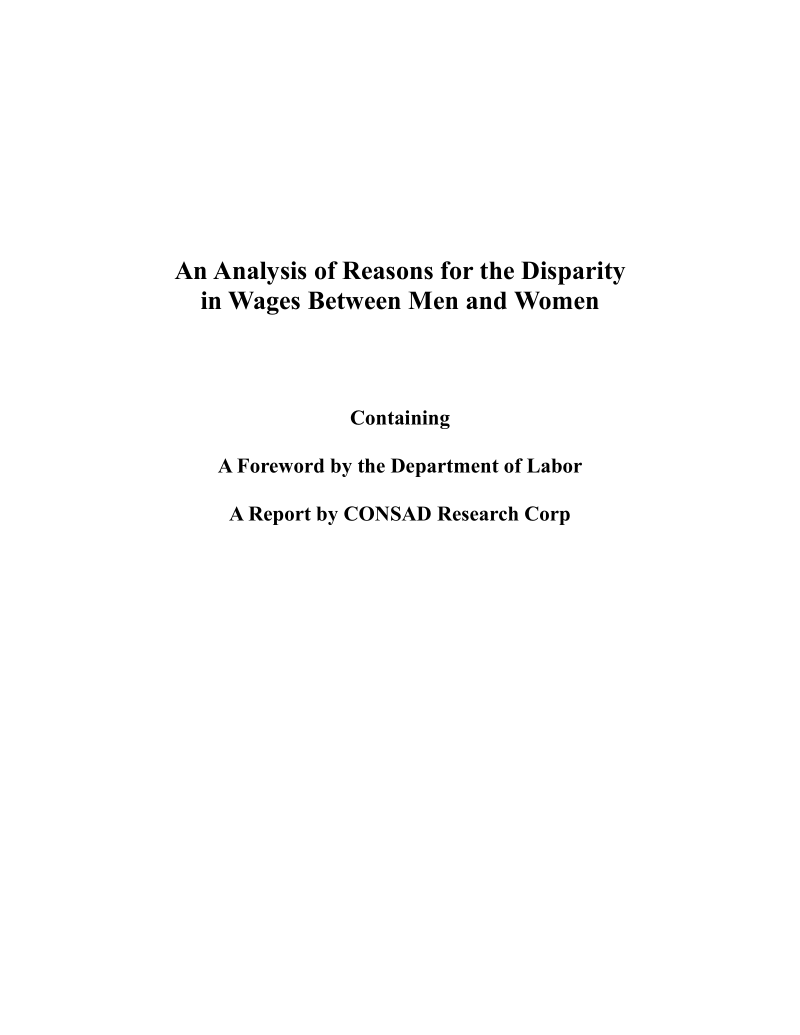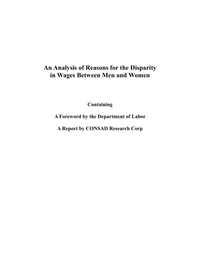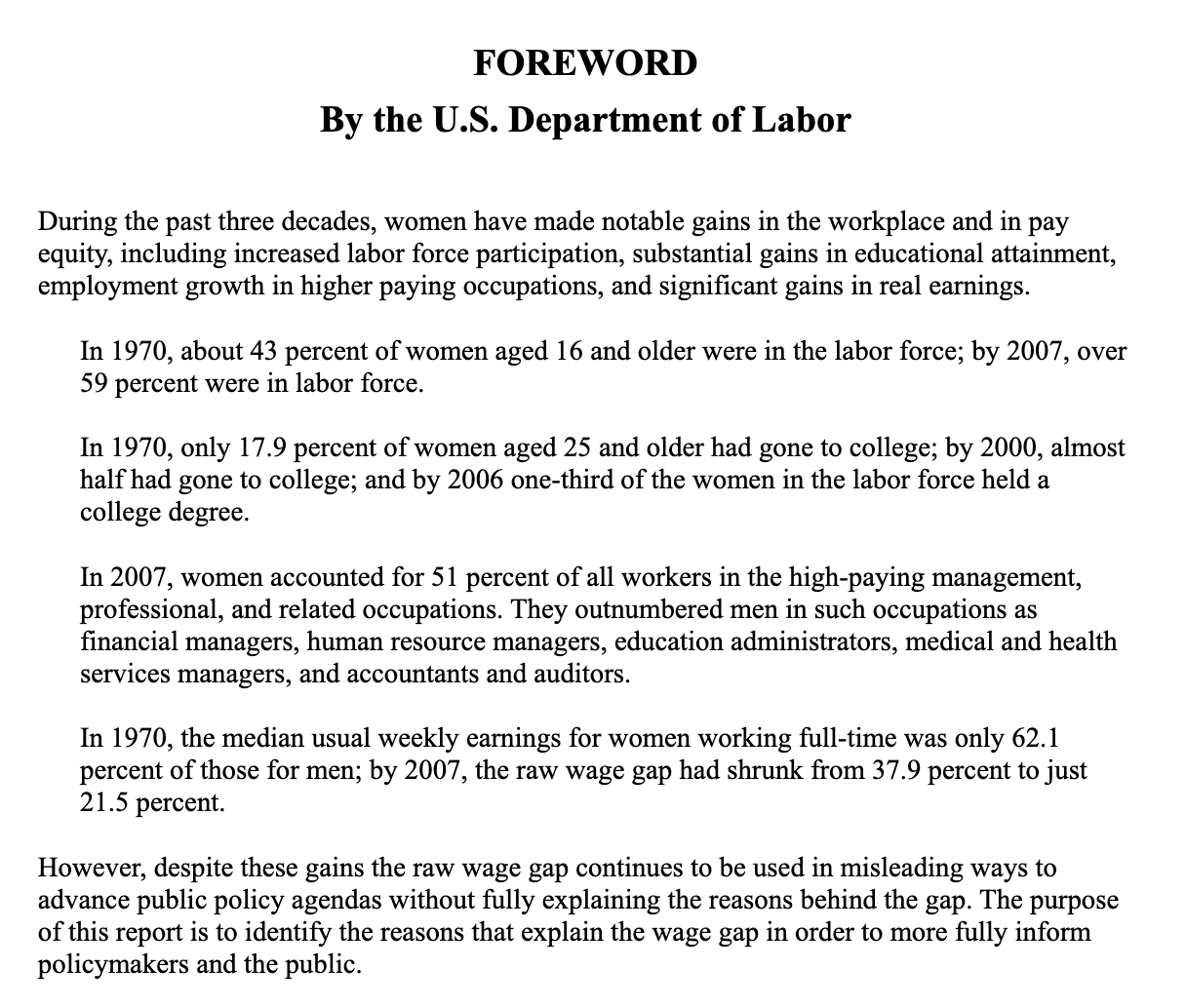US Department of Labor states that the unadjusted gender wage gap can be "used in misleading ways".
- Type
- Academic / Technical Report
- Source
- US Department of Labor Non-LDS
- Hearsay
- Secondary
- Reference
CONSAD Research Corporation, "An Analysis of Reasons for the Disparity in Wages Between Men and Women," Final Report prepared for the U.S. Department of Labor, January 12, 2009, 1-2, accessed January 24, 2022
- Scribe/Publisher
- CONSAD Research Corporation
- People
- CONSAD Research Corporation, US Department of Labor
- Audience
- Reading Public
- Transcription
. . .
FOREWORD
By the U.S. Department of Labor
During the past three decades, women have made notable gains in the workplace and in pay equity, including increased labor force participation, substantial gains in educational attainment, employment growth in higher paying occupations, and significant gains in real earnings.
In 1970, about 43 percent of women aged 16 and older were in the labor force; by 2007, over 59 percent were in labor force.
In 1970, only 17.9 percent of women aged 25 and older had gone to college; by 2000, almost half had gone to college; and by 2006 one-third of the women in the labor force held a college degree.
In 2007, women accounted for 51 percent of all workers in the high-paying management, professional, and related occupations. They outnumbered men in such occupations as financial managers, human resource managers, education administrators, medical and health services managers, and accountants and auditors.
In 1970, the median usual weekly earnings for women working full-time was only 62.1 percent of those for men; by 2007, the raw wage gap had shrunk from 37.9 percent to just 21.5 percent.
However, despite these gains the raw wage gap continues to be used in misleading ways to advance public policy agendas without fully explaining the reasons behind the gap. The purpose of this report is to identify the reasons that explain the wage gap in order to more fully inform policymakers and the public.
. . . .
There are observable differences in the attributes of men and women that account for most of the wage gap. Statistical analysis that includes those variables has produced results that collectively account for between 65.1 and 76.4 percent of a raw gender wage gap of 20.4 percent, and thereby leave an adjusted gender wage gap that is between 4.8 and 7.1 percent. These variables include:
A greater percentage of women than men tend to work part-time. Part-time work tends to pay less than full-time work.
A greater percentage of women than men tend to leave the labor force for child birth, child care and elder care. Some of the wage gap is explained by the percentage of women who were not in the labor force during previous years, the age of women, and the number of children in the home.
Women, especially working mothers, tend to value “family friendly” workplace policies more than men. Some of the wage gap is explained by industry and occupation, particularly, the percentage of women who work in the industry and occupation.
Research also suggests that differences not incorporated into the model due to data limitations may account for part of the remaining gap. Specifically, CONSAD’s model and much of the literature, including the Bureau of Labor Statistics Highlights of Women’s Earnings, focus on wages rather than total compensation. Research indicates that women may value non-wage benefits more than men do, and as a result prefer to take a greater portion of their compensation in the form of health insurance and other fringe benefits.
In principle, more of the raw wage gap could be explained by including some additional variables within a single comprehensive analysis that considers all of the factors simultaneously; however, such an analysis is not feasible to conduct with available data bases. Factors, such as work experience and job tenure, require data that describe the behavior of individual workers over extended time periods. The longitudinal data bases that contain such information include too few workers, however, to support adequate analysis of factors like occupation and industry. Cross-sectional data bases that include enough workers to enable analysis of factors like occupation and industry do not collect data on individual workers over long enough periods to support adequate analysis of factors like work experience and job tenure.
Although additional research in this area is clearly needed, this study leads to the unambiguous conclusion that the differences in the compensation of men and women are the result of a multitude of factors and that the raw wage gap should not be used as the basis to justify corrective action. Indeed, there may be nothing to correct. The differences in raw wages may be almost entirely the result of the individual choices being made by both male and female workers.
. . .
- Citations in Mormonr Qnas
The B. H. Roberts Foundation is not owned by, operated by, or affiliated with the Church of Jesus Christ of Latter-day Saints.



